Study of the influence of fluorine containing compounds
on the physical and chemical and optical properties of glasses of new fluorophosphate
systems.
Member of RAS Dr. G.T. Petrovsky, S.V. Liubimova, L.N. Urusovskaya
Research and technology institute of the science of optical
materials " Vavilov's State Optical Institute"
The work has been supported by a grant and represented by Fluorine
compounds Technology Fund (FTF).
1. Investigation strategy
A phosphate system of Ba(PO3 ) 2-Al(PO3) 3 -Ln(PO3) 3 ( Ln = Ln,Y) has been chosen as a basis
for following introduction of fluorides. To produce glasses of fluorophosphate
crown glass type the following fluorides were introduced in the glass of
the chosen system: BaF2, ZnF2, Ga F3, AlF3,
In F3, Sc F3, Y F3, LaF3.
The synthesis of the glasses was carried out in laboratory furnaces equipped
with silit heaters.
The glasses containing the fluorides were melt in platinum crucibles at a temperature
of 1200-1250oC for 1.5 hours at vigorous stirring.
Reagents of "extremely pure", "chemically pure" and "analytically pure" grade
were used for the synthesis. Fluorides of gallium and indium were introduced
via GaF3*3H2O and InF3*3H2O.
All samples were subjected to fine annealing.
The optical constants of the glasses were measured on a GS-5 tone meter and
a refractometer IRF-23, the instrument error was plus-minus 1*10-5 and plus-minus 1*10-4 respectively.
The density of the glasses was measured by a method of hydrostatic weighing in
toluene to within plus-minus 0.001g/cm3.
The crystallization ability of the glasses was determined by a method of forced
crystallization in a gradient furnace.
The IR spectra were recorded on a IKS-29 instrument (samples as tablets with
KBr) within a range of 1400-400cm-1.
The transmission spectra in UV and visible spectrum were recorded on a SPECORD-UV-VIS
instrument.
2.Study of the glasses of Ba(PO3 ) 2-Al(PO3)
3 -La(PO3) 3 -Y(PO3) 3 -RFx
system.
To study the influence of fluorine - containing compounds into glasses - bases
such as Ba(PO3 ) 2- 56, Al(PO3) 3 - 14, La(PO3)
3 - 20, Y(PO3) 3 - 10 the following fluorides were introduced: BaF2,
ZnF2, GaF3, AlF3, InF3, ScF3,
YF3, LaF3. We managed to introduce 30 mol.% of BaF2,
ZnF2, GaF3, InF3, 20mol.% of ScF3,
YF3, AlF3 and 10mol.% of LaF3. A further
increase in the content of fluorides brings to crystallization at glass-making.
The crystallization ability of the glasses synthesized is represented in
Fig.1. Introduction
of 10mol% of the mentioned fluorides results in insufficient improvement
of crystallization stability. A further increase in the content of fluorides
brings to a dramatic growth of crystallization tendency.
The index of refraction and average dispersion of the investigated glasses are
increasing with increasing the content of the fluorides.(Fig.3).Only the introduction of 10%
of AlF3 does not change the index of refraction at a simultaneous
increase in the average dispersion. The density of the glasses also is increasing
at the introduction of the fluorides (Fig.4). The least increase in the density occurs when AlF3 and ScF3 are introduced. The greatest increase in the density takes place when BaF2 and InF3 are introduced.
Such a change in the index of refraction and density may witness that a considerable
amount of fluorine is evaporated during the synthesis. This conclusion was
made on the basis of a comparison with the data of influence of fluorides
on fluorophosphate bases. A chemical analysis of the glasses synthesized
was carried out. Due to a high temperature of the synthesis (t= 1200o -1500oC) a considerable part of fluorine vaporized that was confirmed
by the variation of the density and optical constants on the content of the
fluorides. The results of the chemical analysis are given in Table
1. The greatest amount of fluorine is in the glasses with scandium fluoride, a little less
amount of fluorine is contained in the glasses with fluorides of aluminum,
yttrium, barium.
Table 1. Results of chemical analysis of the glasses Ba(PO3
) 2-Al(PO3) 3 -La(PO3) 3 -Y(PO3)
3 -RFx system.
| Glass number |
Content of components, mol.%
|
Fluorine content in synthesis, wt.% |
Analytical fluorine content, wt.% |
| Ba(PO3 )2 |
Al(PO3)3 |
La(PO3)3 |
Y(PO3) 3 |
RFx |
| 52 |
50,4 |
12,6 |
18 |
9 |
BaF2-10 |
1,28 |
0,31 |
| 54 |
39,2 |
9,3 |
14 |
7 |
BaF2-30 |
4,22 |
0,76 |
| 71 |
50,4 |
12,6 |
18 |
9 |
GaF3-10 |
1,96 |
0,27 |
| 73 |
39,2 |
9,8 |
14 |
7 |
GaF3-30 |
6,71 |
0,48 |
| 75 |
50,4 |
12,6 |
18 |
9 |
InF3-10 |
1,93 |
0,22 |
| 78 |
39,2 |
9,8 |
14 |
7 |
InF3-30 |
6,37 |
0,62 |
| 81 |
50,4 |
12,6 |
18 |
9 |
ScF3-10 |
1,97 |
0,62 |
| 82 |
44,3 |
11,2 |
16 |
8 |
ScF3-20 |
4,24 |
1,04 |
| 84 |
50,4 |
12,6 |
18 |
9 |
AlF3-10 |
1,98 |
0,37 |
| 85 |
44,3 |
11,2 |
16 |
8 |
AlF3-20 |
4,29 |
0,65 |
| 87 |
50,4 |
12,6 |
18 |
9 |
YF3-10 |
1,94 |
0,51 |
| 88 |
44,3 |
11,2 |
16 |
8 |
YF3-20 |
4,11 |
0,76 |
| 90 |
50,4 |
12,6 |
18 |
9 |
LaF3-10 |
1,91 |
0,59 |
| 95 |
50,4 |
12,6 |
18 |
9 |
ZnF2-10 |
1,31 |
0,28 |
| 97 |
39,2 |
9,3 |
14 |
7 |
ZnF2-20 |
4,59 |
0,57 |
The transmission in UV and visible spectrum was measured:  was measured from 270 to 340 nm (Fig.5). A shift of the transmission cut-off to the long-wave region at introduction
of the fluorides can be due to interaction of the melt with air. was measured from 270 to 340 nm (Fig.5). A shift of the transmission cut-off to the long-wave region at introduction
of the fluorides can be due to interaction of the melt with air.
The greatest deviation from a "normal straight line" is observed for the glasses
containing fluorides of scandium, yttrium, barium:  +6 - +8. +6 - +8.
A study of a possibility to introduce greater amount of fluorides into glasses
has shown that the introduction in the glass-base of 55mol% of BaF2 resulted in formation of a glassy phase with crystal inclusions during glass-making.
To reduce the crystallization rate, MgF2 was introduced into the glasses
of Ba(PO3 ) 2-Al(PO3) 3 -La(PO3)
3 -Y(PO3) 3 -BaF2 system. During the glass –making on a cold
plate it was managed to produce a glass. The replacement of BaF2 and Ba(PO3)2 with BaO allowed to obtain volume samples
of glasses and to measure their optical characteristics.
The compositions of the synthesized glasses and their optical characteristics
are given in Table 2. The crystallization ability of the
synthesized glasses is presented in Fig.6. The experimental results have shown that the replacement of Ba(PO3 ) 2 with BaO results in a reduction in the index of refraction
and average dispersion. A negligible improvement of the crystallization stability
was observed at the replacement of BaF2 with SrF2 and/or
BaO. The replacement of BaF2 with BaO led to a growth of the index
of refraction and average dispersion. To reduce the crystallization ability,
the content of MgF2 in the composition of glass was increased
up to 30 mol.% and 1mol.% of AlF3 was added (glass No157).That
resulted in a considerable improvement in resistance to crystallization
(Fig.6).The optical constants of the glasses were: ne=
1,5835,  =68,2, =68,2,  +11. +11.
Table 2. Composition of the glasses and their optical constants.
| Glass number |
Content of components, mol. % |
ne |
(nF' - nc' ) |
 |
| Ba(PO3)2 |
Al(PO3)3 |
La(PO3)3 |
Y(PO3)3 |
BaF2 |
MgF2 |
SrF2 |
AlF3 |
BaO |
| 110 |
22,4 |
5,6 |
8 |
4 |
50 |
10 |
- |
- |
- |
|
|
|
| 111 |
16,8 |
4,2 |
6 |
3 |
50 |
20 |
- |
- |
- |
|
|
|
| 112 |
11,8 |
4,2 |
6 |
3 |
50 |
20 |
- |
- |
5 |
1,5889 |
885 |
66,5 |
| 115 |
6,8 |
4,2 |
6 |
3 |
50 |
20 |
- |
- |
10 |
1,5793 |
844 |
69 |
| 119 |
4,3 |
4,2 |
6 |
3 |
50 |
20 |
- |
- |
12,5 |
1,5767 |
836 |
69 |
| 117 |
1,8 |
4,2 |
6 |
3 |
50 |
20 |
- |
- |
15 |
1,5747 |
830 |
69 |
| 121 |
4,3 |
4,2 |
6 |
3 |
45 |
20 |
- |
- |
17,5 |
1,5813 |
848 |
68,5 |
| 128 |
11,8 |
4,2 |
6 |
3 |
40 |
20 |
10 |
- |
5 |
1,5868 |
879 |
66,8 |
| 131 |
11,8 |
4,2 |
6 |
3 |
30 |
20 |
10 |
- |
15 |
1,5902 |
891 |
66,2 |
| 157 |
6,8 |
4,2 |
6 |
3 |
20 |
30 |
10 |
1 |
25 |
1,5835 |
855 |
68,2 |
The transmission in UV and visible spectrum was determined for all synthesized
glasses. for 10mm thickness of a sample was
within a range of 335-340nm (Fig.7).
Possible ways to improve the transmission are synthesis in controllable atmosphere
or a change of temperature-time parameters of glass-making. for 10mm thickness of a sample was
within a range of 335-340nm (Fig.7).
Possible ways to improve the transmission are synthesis in controllable atmosphere
or a change of temperature-time parameters of glass-making.
Conclusions
- Glass-making systems to introduce fluorides have been chosen
- The influence of fluorine-containing compounds on the optical and physical-chemical
properties of fluorophosphate systems has been studied.
- It has been shown that the introduction of fluorides of scandium, yttrium,
barium into glasses results in obtaining glasses with a deviation from
the "normal straight line":
 +6 - +8. +6 - +8.
- Introduction of magnesium fluoride and aluminum fluoride into glass results
in a decrease of the deviation from the "normal straight line" to
 +11. +11.
- Introduction of fluorine-containing compounds into optical glass of the studied
systems provides 99% transmission within a range of 365-40 nm.
Fig.1 Crystallization of glasses of
Ba(PO3)2-Al(PO3)3-La(PO3)3-Y(PO3)3-RFx system. 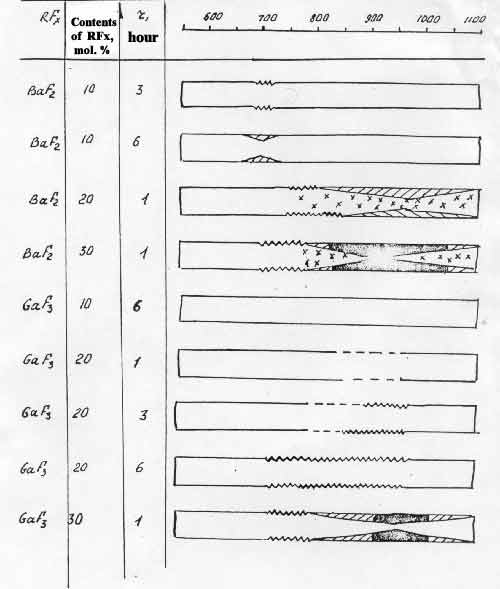
Fig.2 The index of refraction versus the
content of fluorides 
Fig.3 The average dispersion versus the
content of fluorides 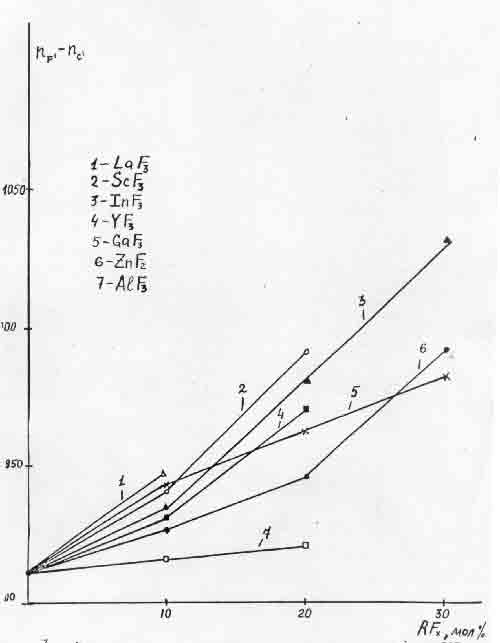
Fig.4 The density versus the content of
fluorides 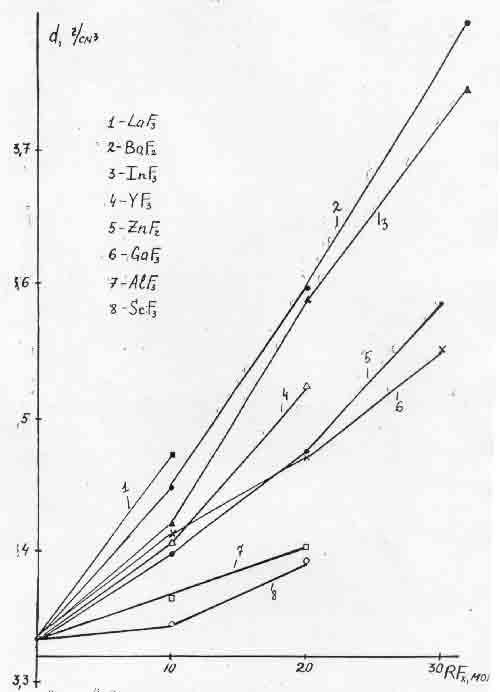
Fig.5 The transmission spectra of the
glasses of Ba(PO3)2-Al(PO3)3-La(PO3)3-Y(PO3)3-RFx system in UV and visible spectrum. The
thickness of the samples is 10mm. 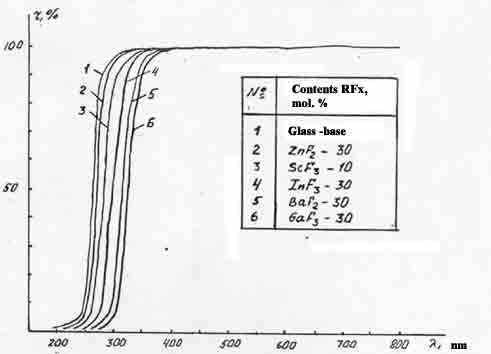
Fig.6 Crystallization of the synthesized
fluorophosphate glasses (aging time, hours) 
Fig.7 The transmission spectra of
fluorophosphate glasses in UV and visible spectrum. The thickness of the samples is 10mm. 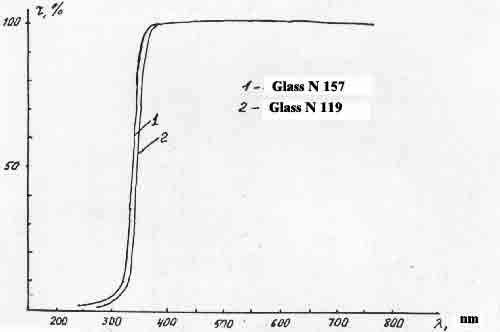
|